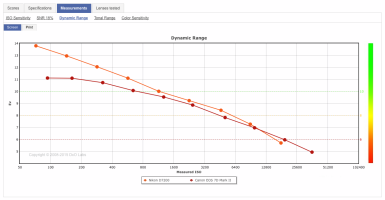Bdunbar79 wrote: “
But so what? More DR at low ISO doesn't give you better IQ. It only does if you push shadows. That’s it.”.
As I wrote in my start of this thread: that is exactly what I need and what I am looking for.

All replies pointing out that there is more to the 7D Mark II than the DR of its sensor, make a valid point (of course

). Johnf3f wrote: “
I think that Alan F is getting at the point that good/excellent AF is a/the major priority for the likes of birds etc. … Naturally image quality is very important but the best sensor in the world won't get to a decent bird shot if the AF isn't up to the job”.
You are very right: an out-of-focus image from a sensor with a DR of 20 stops is of no use. Clearly.
But it is not that I do not get enough in-focus shots. This means that although I would not mind having all great features of the 7D Mark II 8) , I can do without them. Together with the fact that I can afford to occasionally miss a shot, I do not have to improve my number of keepers. To be honest, the main reason for the out-of-focus shots that I do have, is usually that I did not recognize a changing situation in the environment that impacted my AF-settings (like lighting, relative speed, size of the plane, color or tone of the plane, changing background, etc.).
As I wrote before, when shooting airplanes you cannot control the lighting - or even come back later (like with architecture and landscape). You have to take what you get.
So when the sky is not evenly clouded, the harsh sunlight in combination with the geometry of airplanes will result in quite some underexposure of the underside of the fuselage and wings.
In such circumstances the raw photos will have deep shadows. It is clear that in such circumstances it is paramountto to set exposure with post-processing in mind. This requires knowing your equipment. That has all been pointed out, and rightfully so. But still, the deep shades are what you inevitably get and must be dealt with in post-processing.
Noise as a result of pushing the shades ‘too much’ in post-processing is quickly visible on smooth metal surfaces – like wings or other surfaces of an aircraft!
So I conclude that for my type of photography, avoiding noise in shades is critical. This means that a bit more latitude as a result of a bigger DR of the sensor, would allow for a better result in post-processing.
Hence my need for a sensor with better DR. I can be more specific after giving it some more thought based on several replies above: I need better DR in particular from 400 to 800 ISO.
The things I have read about the DR of the 7D Mark II are sometimes very good and at other times not that good. However, not one of them is clearly less true. There is simply too much variation from poster to poster and from website to website to be undisputed enough to base my judgement on. The 80D seems to have a sensor with better DR – although there also is some variance in the amount by which it is better.
To finish, in another thread I have read that the 7D Mark III (three) might come sooner than the normal cycle would suggest because of competition from both the 80D and the likes of the Nikon D500 (although the latter is much more expensive, so I am not sure if that is really fair to say).
At first I thought it could be wise to wait for that new 7D Mark III, hoping I might get both the better DR of the newer generation of sensors Canon appears to produce now, and the better AF-system, ergonomics and ‘action photography features’.
But that I will not do. Because no doubt the camera after that will be even better… and so on.
So the 80D it will be!
Thanks for all replies and useful information. It helped me get a clearer picture

of my own needs

